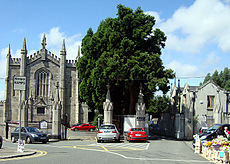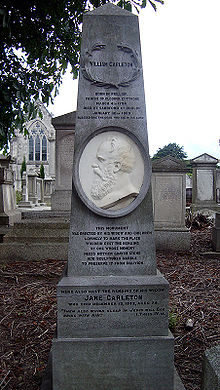- Mount Jerome Cemetery
-
Mount Jerome Cemetery 
The entrance to Mt. Jerome, on right.Details Year established 1836 Country Ireland Location Harold's Cross, Dublin Coordinates 53°19′29″N 6°16′48″W / 53.32472°N 6.28°W Type Public Owned by General Cemetery Company of Dublin Number of graves Over 300,000 Mount Jerome Cemetery (Irish: Reilig Chnoc Ieróim) is situated in Harold's Cross on the south side of Dublin, Ireland.[1] Since its foundation in 1836, it has witnessed over 300,000 burials. Originally an exclusively Protestant cemetery, Roman Catholics have also been buried there since the 1920s.
Contents
History
The name of the cemetery comes from an estate established there by the Reverend Stephen Jerome, who in 1639 was vicar of St. Kevin's Parish. At that time Harold's Cross was part of St. Kevin's Parish. In the latter half of the 17th century, the land passed into the ownership of the Earl of Meath, who in turn leased plots to prominent Dublin families. A house, Mount Jerome House, was constructed in one of these plots, and leased to John Keogh. In 1834, after an aborted attempt to set up a cemetery in the Phoenix Park, the General Cemetery Company of Dublin bought the Mount Jerome property, "for establishing a general cemetery in the neighbourhood of the city of Dublin".[2]
The Funerary Chapel in the cemetery was the first Puginian Gothic church in Dublin. It was designed by William Atkins.
Notable burials
Notable people buried here include:[3][4]
- Robert Adams (1791–1875), physician and professor of surgery
- Edward Bunting (1773–1843), musician, music-collector
- Frederick William Burton (1816–1900), painter and director of the National Gallery
- Peter Caffrey (1949–2008), actor (Ballykissangel)
- Sir Charles Cameron (1830–1921), for 50 years head of the Public Health Department of Dublin Corporation, along with two of his sons, Charles J. and Ewen Henry
- James Campbell, 1st Baron Glenavy (1851–1931), lawyer, politician and Lord Chancellor of Ireland
- William Carleton (1794–1869), writer
- Thomas Caulfield Irwin (1823–1892), poet, writer, scholar
- Abraham Colles (1773–1843), surgeon, professor of medicine
- John Augustus Conolly VC (1829–1888), soldier
- Paddy Daly (1888-1957), member of the IRA during the War of Independence and later Major-General in the Irish Army
- Achilles Daunt (1832–1878), preacher and homilist
- Thomas Davis, (1814–1845), journalist, politician, founder of The Nation newspaper
- Thomas Drummond (1797–1840), surveyor, Under-Secretary for Ireland
- James Fitzgerald (1899–1971), American painter
- Ethel Kathleen French (née Moore, 1871-1891), artist and illustrator, first wife of Percy French. She died in childbirth with their first child.
- Edward Gibson, 1st Baron Ashbourne (1837–1913), lawyer and Lord Chancellor of Ireland
- Robert Graves (1796–1853), professor of medicine and writer
- Sir Richard John Griffith (1784–1878), geologist, mining engineer, chairman of the Board of Works, author of Griffith's Valuation
- Thomas Grubb (1800–1878), optician, telescope-maker
- Benjamin Guinness (1798–1868), brewer, philanthropist, and other members of the Guinness family
- George Halpin (Sr.) (1779–1854), civil engineer and lighthouse builder
- William Rowan Hamilton (1805–1865), mathematician and astronomer
- James Haughton (1795–1873), social reformer
- John Kells Ingram (1823–1907), politician, scholar, poet ("The Memory of the Dead")
- John Hewitt Jellett (1817–1888), Provost of Trinity College
- John Edward Jones (1806–1862), civil engineer and sculptor
- Joseph Robinson Kirk (1821-1894), sculptor, who also executed the figure over the memorial of his father, Thomas
- Thomas Kirk (1781–1845), sculptor, who also designed the Butler mausoleum in this cemetery[5]
- John Mitchell Kemble, scholar
- Joseph Sheridan Le Fanu (1814–1873), writer and editor, along with his wife, Susanna Bennett, her father and two brothers, in the same vault.
- Thomas Hawkesworth Ledwich (1823–1858), surgeon and anatomist
- Thomas Langlois Lefroy (1776–1869), politician and judge
- David Marcus (1924–2009), Irish Jewish writer, editor
- Sir Henry Marsh (1770–1860), physician
- William Fetherstone Montgomery (1797-1859), obstetrican
- Hans Garrett Moore VC (1830–1889), soldier
- Arthur Thomas Moore VC (1830–1912), soldier
- Sir Richard Morrison (1767–1849), architect (Pro-Cathedral, Trinity College, etc.)[5]
- William Vitruvius Morrison (1794–1838), architect; son and partner of Richard Morrison.[5]
- John Skipton Mulvany (1813–1870), architect who also designed a number of monuments in this cemetery, including the Mahony monument and Perry and West vaults[5]
- Máirtín Ó Cadhain (1906–1970), Irish-language writer[6]
- Walter Osborne (1859–1903), artist
- Peter Marshall (died 1890), prominent member of the Masonic and Orange Orders
- William McFadden Orr (1866–1934), mathematician
- George Papworth (1781–1855), architect
- Jacob Owen (1778–1870), architect and engineer to the Board of Works
- Edward Arthur Henry Pakenham, 6th Earl of Longford (1902–1961) was an Irish peer, politician, and littérateur
- George Petrie (1790–1886), artist, archaeologist, musician
- William Plunket, 4th Baron Plunket (1828–1897), Archbishop of Dublin
- Sarah Purser (1848–1943), artist
- George Russell (1867–1935), writer, artist
- Cecil Sheridan (1910–1980), comedian and actor[7]
- John Skelton (1924-2009), artist and illustrator.
- Ellen Smyly (1815-1901) founder of the Smyly Homes.
- Robert William Smith (1807–1873), pathologist
- John Millington Synge (1871–1909), playwright
- Isaac Weld (1774–1856), topographical writer, explorer and artist.[5]
- William Wilde, father of Oscar Wilde. His wife, Jane Francesca Elgee, is commemorated on Sir William's monument, but she was buried in Kensal Green Cemetery in London.
- S. Allen Windle (1828–1880), Chaplain of the Mariners' Church, Dún Laoghaire[8]
- Edward Perceval Wright (1834–1910), ophthalmic surgeon, botanist and zoologist
- Jack Butler Yeats (1871–1957), artist
There is a large plot to the deceased members of the Royal Irish Constabulary and the Dublin Metropolitan Police.[3] The remains of French Huguenots from St. Peter's Churchyard, Peter's Row (now the location of the Dublin YMCA), which was demolished in the 1980s, and from St. Brigid's and St. Thomas's churchyards are interred in the cemetery.[3][9]
Over 200 children of unmarried mothers who died in the Bethany Home were buried in unmarked graves in the cemetery.[10]
Recent burials include the notorious Martin Cahill (1949–1994) (known as "The General"). His gravestone has been vandalised on numerous occasions and is currently broken in two with the top half missing. His body has since been removed to an unmarked grave in the cemetery.[citation needed]
Flora
The cemetery has one of only two Christ-thorn bushes in Ireland (the other is in the Botanic Gardens).[3]
Literary references
- Then Mount Jerome for the protestants. Funerals all over the world everywhere every minute. Shovelling them under by the cartload doublequick. Thousands every hour. Too many in the world. Ulysses, Chapter 6, Hades episode, James Joyce.
References
- ^ Somerville-Large, Peter (1988). Dublin: The First Thousand Years. Belfast: The Appletree Press. p. 226. ISBN 0862812062.
- ^ Igoe, Vivien. Dublin Burial Grounds & Graveyards. Wolfhound Press, 2001. p. 172
- ^ a b c d Langtry, Joe and Nikki Carter, eds. Mount Jerome: A Victorian Cemetery. Staybro Printing Ltd., Dublin 1997.
- ^ Boylan, Henry (1998). A Dictionary of Irish Biography, 3rd Edition. Dublin: Gill and MacMillan. ISBN 0-7171-2945-4.
- ^ a b c d e Patao, Sofia (2000). Funeral Art and Architecture. Dublin: EEC. ISBN 84-8156-270-X.
- ^ Reporter (20 October 1970), "Obituary", The Irish Times: 13
- ^ The Irish Times, "Final tribute to Cecil Sheridan", 8 January, 1980
- ^ Irish Times, Dublin, 29 January 1880
- ^ St. Peter's Churchyard Excavation Report
- ^ Graves of Bethany children 'located at Mount Jerome' by Patsy McGarry Irish Times, 21st May 2010
External links
Categories:- Cemeteries in County Dublin
- Buildings and structures in Dublin (city)
- Burials at Mount Jerome Cemetery
- Visitor attractions in Dublin (city)
- Religion in Dublin (city)
Wikimedia Foundation. 2010.


